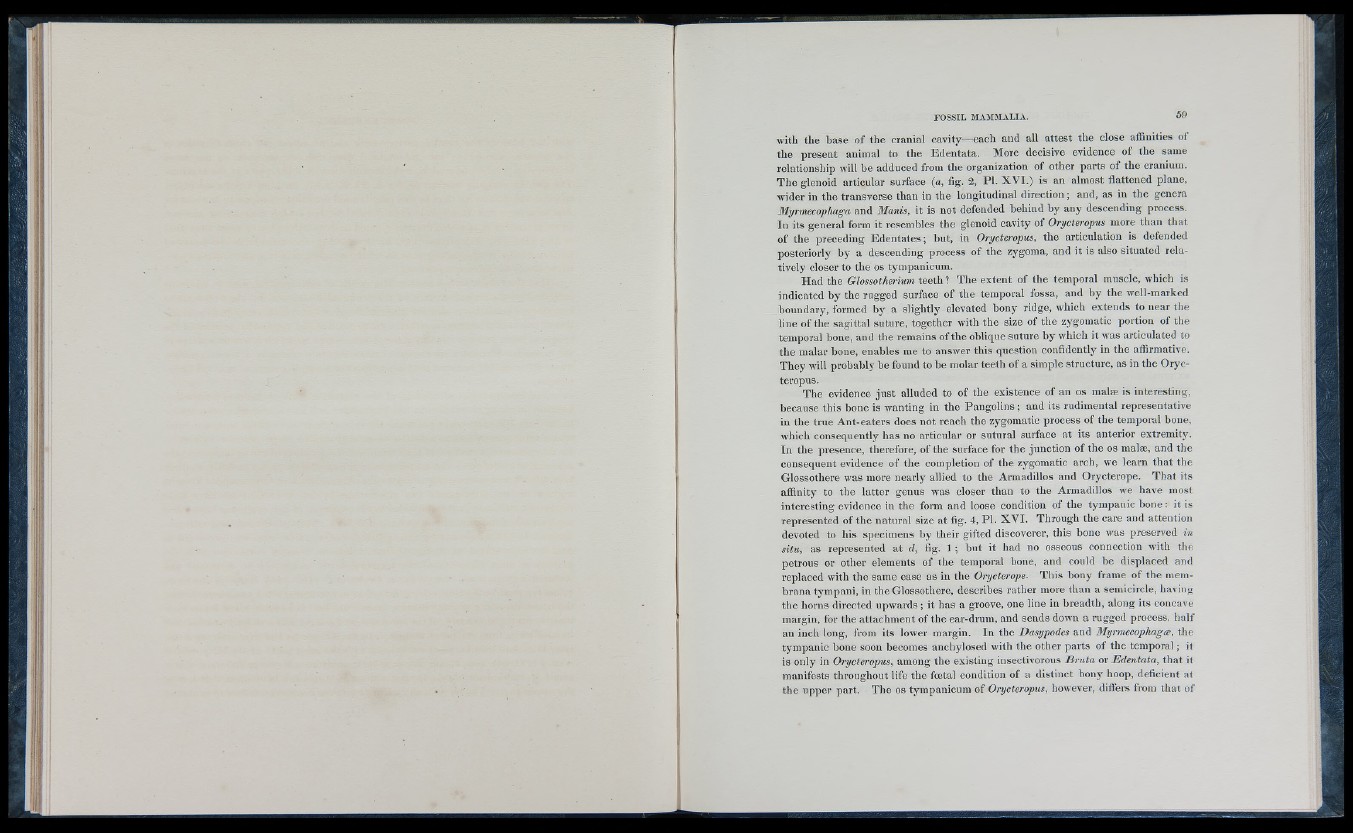
with the base o f the cranial cavity—each and all attest the d o s e affinities of
the present animal to the Edentata. More decisive evidence o f the same
relationship will be adduced from the organization o f other parts o f the cranium.
The glenoid articular surface (a, fig. 2 , PI. X V I .) is an almost flattened plane,
wider in the transverse than in the longitudinal direction ; and, as in the genera
Myrmecophaga and Manis, it is not defended behind by any descending process.
In its general form it resembles the glenoid cavity o f Onjcteropus more than that
o f the preceding E d en ta te s; hut, in Orycteropus, the articulation is defended
posteriorly b y a descending process o f the zygoma, and it is also situated relatively
closer to the os tympanicum.
Had the Glossotherium te<Ahl The ex ten t o f the temporal muscle, which is
indicated b y the rugged surface o f the temporal fossa, and b y the well-marked
boundary, formed by a slightly elevated bony ridge, which extends to near the
line o f the sagittal suture, together with the size o f the zygomatic portion o f the
temporal hone, and the remains o f the oblique suture b y which it was articulated to
the malar hone, enables me to answer this question confidently in the affirmative.
They will probably be found to he molar teeth o f a simple structure, as in the Orycteropus.
The evidence ju st alluded to o f the existenc e o f an os malæ is interesting,
because this bone is wanting in the Pangolins ; and its rudimental representative
in the true Ant-eaters does not reach the zygomatic process o f the temporal bone,
which consequently has no articular or sutural surface at its anterior extremity.
In the presence, therefore, o f the surface for the junction o f the os malæ, and the
consequent evidence o f the completion o f the zygomatic arch, we learn that the
Glossothere was more nearly allied to the Armadillos and Orycterope. That its
affinity to the latter genus w'as closer than to the Armadillos we have most
interesting evidence in the form and loose condition o f the tympanic bone : it is
represented of the natural size at fig. 4, PI. X V I . Through the care and attention
devoted to his specimens by their gifted discoverer, this bone was preserved in
situ, as represented at d, fig. 1 ; hut it had no osseous connection wdth tlie
petrous or other elements o f the temporal bone, and could be displaced and
replaced with the same ease as in the Orycterope. Th is bony frame o f the inem-
hrana tympani, in the Glossothere, describes rather more than a semicircle, having
the horns directed upwards ; it has a groove, one line in breadth, along its concave
margin, for the attachment o f the ear-drum, and sends down a rugged process, h a lf
an inch long, from its lower margin. In the Dasypodes and ilyrmecophagce, the
tympanic hone soon becomes anchylosed with the other parts of the temporal ; it
is only in Orycteropus, among the ex isting insectivorous B ru ta or Edentata, that it
manifests throughout life the foetal condition o f a distinct bony hoop, deficient at
the upper part. Th e os tyinpanicum o f Orycteropus, however, differs from that o f